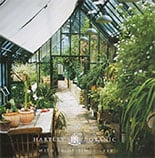August, a word defined as ‘inspiring reverence, admiration, dignity and grandeur’ in the dictionary, does not really define this late-summer month at all. Most gardens are tired and lacklustre and especially so in drought-stressed 2025. The subdued summer flourish has been and gone and the autumnal cavalcade is still waiting in the wings. And I’m hoping, or should that be praying, that some much-needed rainfall will reignite September because the weather’s been especially brutal this year.
In the Cotswolds we’ve experienced cloudless summer days, with temperatures topping 30C. My south-facing garden has taken the full brunt because it catches the sun’s rays throughout the day. I used to think being south-facing was a huge advantage, having all that extra sunshine used to seem a boon. However, climate change is warming up the planet and my south-facing stone walls are radiating heat, inside and out. It wasn’t the hot summer sunshine that caused the real damage to my garden though, it was the exceptionally dry spring and cold nights. There wasn’t a spring spurt, when everything looked lush and full of promise. Mine was like a damp squib.

My garden’s designed to be attractive in every season and I’ve been inspired by two fantastic women. The first was Margery Fish, who I never met. She gardened at East Lambrook Manor in Somerset, from 1937 until her death in 1969, and she pioneered the use of hardy geraniums, pulmonarias and astrantias way before anyone else. She wrote several best-selling books, but the one I love is a A Flower for Every Day published in 1965. This is a lovely read, written when most gardens were pin-neat with uninspiring planting beyween May and August. One-week affairs, like cottage garden peonies, P. officinalis, and lupins, dominated post-war gardens. I’m not a fan of either, sorry. Many plants bear the name Lambrook, after her garden and she is credited with naming a large white astrantia ‘Shaggy’.
Beth Chatto, who founded a nursery and garden in Essex, was inspiring as well. I was lucky enough to meet Beth on several occasions and, if I mentioned the nursery selling one of her plants, she would often write to me. I particularly admired the poetic way she described plants in her yearly green catalogue, entitled A Handbook of Plants. She called astrantias mini posies, reflecting their old-fashioned name of Hattie’s pincushion. Beth, who was a flower arranger, looked for the detail and combined her plants really well, whether it was in her Essex nursery at Elmstead Market, or at Chelsea. She had dry areas above gravel and damp riverside borders and she pioneered the right plant, right place idea, although she always credited her husband Andrew for this ecological approach. The nursery and garden continue under her granddaughter, Julia Boulton, following Beth’s passing in 2018.
Margery inspired me to have flowers throughout the year and Beth taught me to grow them in the right positions. As a result, my gardens contain seasonal borders. There’s a spring hotspot, containing trilliums, woodlanders and ferns, in the sheltered south- eastern corner under a woody canopy of winter-flowering witch hazels and daphnes. The late-flowering asters and autumn-flowering plants are all together, on the south-western edge, and they begin to shine from August onwards. Evening sun flatters them as the days shorten. The summer borders, peonies, roses and phloxes, span the front of the cottage and face south.

Having three distinct areas, for spring and summer and autumn, helps me maintain the garden because I can tackle one section at a time. In August I tidy the spring borders, so they look pristine in winter. It has to be done in the first half of August, because the summer-dormant polypodies produce new foliage from then onwards. By September the bulbous plants, including trilliums, erythroniums and snowdrops, are beginning to root once again so they would not appreciate overhead trampling. Shrubs are pruned here, if needed, and this year I must reduce the over-expansive winter-flowering honeysuckle, Lonicera x purpusii ‘Winter Beauty’. A shame, for I will be cutting away the buds and shall have less flower and less fragrance. I extend this autumn border with named forms of Hydrangea paniculata, although these have been held back by the dry conditions.
In September, I begin to work on the summer borders, cutting down anything with fading foliage, including peonies and phloxes. The roses get reduced by one third, once they’ve finished their second flush, so that the wind doesn’t rock them about for my garden is exposed to the south-westerlies. Normally the border is extended into autumn with cosmos, annual scabious, penstemon and Gaura lindheimeri. The latter has now been renamed Oenothera lindheimeri and it’s easy to raise from seeds sown in April. The white flowers of this willowy plant are softened by rhubarb-pink calices and buds and it will flower into November. The dry weather made it impossible to plant any of these in the summer border this year, so there will no late-season razzamatazz this year.

The last area to be tidied is the autumn border and that’s cut back after Christmas. Quite when depends on the weather. If winter’s dry the stems and seedheads stay erect and cutting down happens in late January. If winter’s soggy, as it was last year, I shall be in there once it flops on the ground. It’s an important area, because the stems offer refuge to insect life. When frost descends, it creates winter interest. When it’s wet it’s like having a series of soldiers in camouflage gear, all khaki, brown and black.
The autumn border edge is planted with colchicums, or autumn crocuses, and I’m hoping for a good show. My autumn-flowering cyclamen, which should be appearing in September, popped up in August this year. Climate change is causing everything to flower earlier. Plants I would have recommended for September sparkle, such as the gentian-blue Ceratostigma plumbaginoides, were out at the end of July. The herbaceous scrambling blue clematis, C. heracleifolia, is now flowering four weeks before September arrives.
The seasonal border approach I mentioned spreads out the work over several months AND it’s so much more effective to look at as well. Every part of the garden can be planted up and you avoid having a tatty peony next to an aster in bud. You won’t find yourself having to shimmy into it to tackle one thing, whilst leaving another. It’s a logistical nightmare and anyone who’s gardened for a long time will tell you, you must be able to maintain the plants. Access is all important.

It’s been an interesting experience to watch the garden and see what’s done well in this dry year. The stars have been the eryngiums, or sea hollies. One plant has had over sixty stems and each one has been topped with a branching head of up to five flowers. The aquamarine flowers, which have been perfect for weeks, have faded to light brown following some rain. I grow ‘Big Blue’ and the smaller E. bourgatii. The latter has finely cut variegated foliage and it self-seeds into the cracks of the stone paving.
Scabious have done very well as well and the button-like pallid-yellow flowers, on slender wands, have positioned themselves close to pots of rich-blue agapanthus and they have enjoyed this summer. ‘Northern Star’ and the almost navy blue ‘Alan Street’ are thriving and their pigment-packed petals have shrugged off harsh sunlight without any problem. The darkest of all is ‘Black Jack’, a deserved winner of the RHS Chelsea Flowers Show Plant of the Year in 2023.
Dark sedums with fleshy leaves have also thrived and my ultimate favourite, ‘José Aubergine’, has been superb. Unfortunately, the red-centred yellow daisies of a heliopsis named ‘Summer Nights’ growing next door have shrivelled and flagged. Silvers have been fine too and the pink-flowered shrubby Phlomis italica has never had so much flower. Last year’s dull summer produced no flowers. The roses have excelled as well.
Gardening is difficult at the best of times and it’s getting harder. Don’t give up on it though. It’s character building, which is what our PE teacher used to say about cross country running – although she wasn’t forced to do it in large bottle-green knickers.











